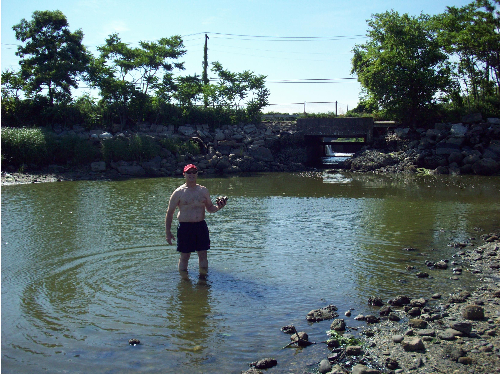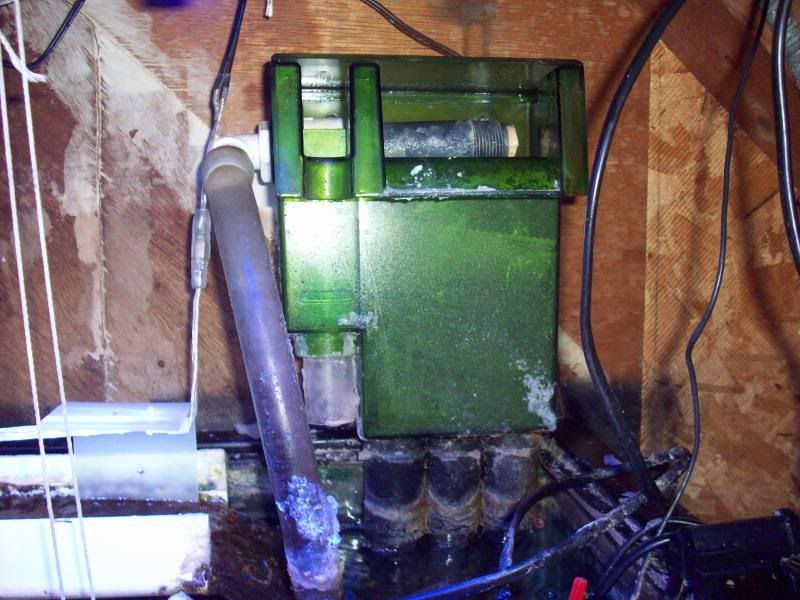Chris, I love fruitcake, and even know quite a few fruitcakes.
I resemble that remark.
Follow along with the video below to see how to install our site as a web app on your home screen.
Note: This feature may not be available in some browsers.
Chris, I love fruitcake, and even know quite a few fruitcakes.
| GEOGRAPHY LESSON....WHAT WASN'T TAUGHT IN SCHOOL...................... |
You're gonna say "I didn't know that!" at least 5 times. Really neat stuff here:
Alaska

More than half of the coastline of the entire
United States is in Alaska.
Amazon

The Amazon rain forest produces more than 20% of the world's oxygen supply
The Amazon River pushes so much water into the Atlantic Ocean that, more than one hundred miles at sea off the mouth of the river, one can dip fresh water out of the ocean. The volume of water in the Amazon river is greater than the next eight largest rivers in the world combined and three times the flow of all rivers in the United States.
Antarctica

Antarctica is the only land on our planet that is not owned by any country Ninety percent of the world's ice covers Antarctica This ice also represents seventy percent of all the fresh water in the world. As strange as it sounds, however, Antarctica is essentially a desert; the average yearly total precipitation is about two inches. Although covered with ice (all but 0.4% of it, ice.), Antarctica is the driest place on the planet, with an absolute humidity lower than the Gobi desert.
Brazil

Brazil got its name from the nut, not the other way around.
Canada

Canada has more lakes than the rest of the world combined. Canada is an Indian word meaning ' Big Village'.
Chicago

Next to Warsaw, Chicago has the largest
Polish population in the world.
Detroit

Woodward Avenue in Detroit, Michigan, carries the designation M-1, so named because it was the first paved road anywhere.
Damascus , Syria

Damascus, Syria, was flourishing a couple of thousand years before Rome was founded in 753 BC making it the oldest continuously inhabited city in existence.
Istanbul , Turkey

Istanbul, Turkey, is the only city in the world
located on two continents.
Los Angeles

The full name of Los Angeles is: l Pueblo de Nuestra Senora la Reina de Los Angeles de Porciuncula
-- and can be abbreviated to 3.63% of its size: L.A.
New York City

The term 'The Big Apple' was coined by touring jazz musicians of the 1930s who used the slang expression 'apple' for any town or city. Therefore, to play New York City Is to play the big time - The Big Apple.
There are more Irish in New York City
than in Dublin, Ireland;
more Italians in New York City
than in Rome, Italy;
and more Jews in New York City
than in Tel Aviv, Israel .
Ohio

There are no natural lakes in the state of Ohio,
every one is man-made
Pitcairn Island

The smallest island with country status is Pitcairn
in Polynesia, at just 1.75 sq. miles/4,53 sq Km.
Rome

The first city to reach a population of 1 million people
was Rome, Italy (in 133 BC.)
There is a city called Rome on every continent.
Siberia

Siberia contains more than 25% of the world's forests.
S.M.O.M.

The actual smallest sovereign entity in the world
Is the Sovereign Military Order of Malta SM.O.M).
It is located in the city of Rome, Italy, and has an area of two tennis courts. And, as of 2001, has a population of 80, 20 less people than the Vatican.
It is a sovereign entity under international law,
just as the Vatican is.
Sahara Desert
In the Sahara Desert , there is a town named Tidikelt, Algeria, that did not receive a drop of rain for ten years. Technically, though, the driest place on Earth
is in the valleys of the Antarctic near Ross Island.
There has been no rainfall there for two million years
Spain

Spain literally means 'the land of rabbits'.
St. Paul , Minnesota

St. Paul , Minnesota , was originally called Pig's Eye
after a man named Pierre 'Pig's Eye' Parrant who set up the first business there.
Russia

The deepest hole ever drilled by man is the Kola Superdeep Borehole, in Russia. It reached a depth of 12,261 meters (about 40,226 feet or 7.62 miles.) It was drilled for scientific research and gave up some unexpected discoveries, one of which was a huge deposit of hydrogen - so massive that the mud coming from the hole was boiling with it.
United States

The Eisenhower interstate system requires that one mile in every five must be straight. These straight sections are usable as airstrips in times of war or other emergencies.
Waterfalls

The water of Angel Falls (the world's highest) in Venezuela drops 3,212 feet (979 meters.) They are 15 times higher than Niagara Falls .

I have always said, you should learn something new every day. Unfortunately, many of us are at that age where what we learn today, we forget tomorrow.
But, give it a shot anyway.

Same for me. 5F with a windchill of -15F. Still managed to stay out for 1 1/2 hours. The dog wasn't ready to come home but I was.
From 2010
I am lucky enough to live on an island surrounded by water that is also full of Islands and all of my life my favorite thing to do is to wander around at low tide in a tide pool.
Yesterday I did just that all by myself. My wife and I went out in our boat to relax and get away from a hectic week and while she read a book in the boat, I took the dinghy to shore to be alone with my friends.
Most of those friends have shells, antenna, fins or feathers.
As I rowed to shore daydreaming I was distracted by the oars hitting the sand and mud of the bay bottom.
I put on the insect repellent (because bugs are not my friends) and I started walking in the tide pool which is about 100 yards across and is composed of mud areas, sand areas, weedy areas and shallow water.
I Pulled the inflatable dingy up on a sandy area and walked through the stream of seawater that feeds the pool.
The first thing I came across was blue claw crabs mating. They were huge and did not appreciate me disturbing them. There were many of them all with the same idea of chasing me away. I don't blame them but they should have gotten a room.
When ever I come across a piece of wood or discarded part of a boat or pier I lift it to see what is living below.
If the object is stuck to the bottom I know there will be nothing living there because of the lack of oxygen it will just be black mud full of stinking hydrogen sulfide. Most heavy objects sink in the mud and that is what happens, but if the object is not too flat and not stuck in the bottom I know it will be just full of life. When you lift an object like that there are dozens of crabs running away, mostly Japanese Shore crabs that took over the native green crabs that are now completely gone. After the mud clears you find huge worms and sometimes clams.
Large amphipods will be jumping from the lifted object to my arm and everywhere else.
Occasionally you see an eel or two dart out.
I always replace the object before I move on. The next area is just filled with oysters and you really can't walk without shoes. The pool shrinks down to about 20 feet across and goes under a road. In that 50' long tunnel with a barnacle covered cement floor you find more blue claw crabs that can't get away or dig in. They just threaten you with their claws as they scamper left and right. The tunnel ends at the other side of the road and becomes fresh water as that is a spill basin for a large lake that emptys here into the sea.
Sometimes you see freshwater turtles resting in the cement spillway that is about 5' high.
Walking back under the road you notice mussels stuck all over the walls covered in barnacles as everything in the Sound is.
I return back to my dinghy on the opposite side of the pool. This side has very low sand dunes that stay wet and are covered in marsh grass. The place is full of 1/2" to 1" wide holes in the sand that are homes to fiddler crabs. If you look ahead about 15' you see the males out of their holes holding up their large claw signaling to the females. I walk through a small salt water stream that leads to a marshy area. Here is where I call horseshoe crab city. The place is just full of tiny newborn horseshoe crabs some just barely visible.
They spend their time plowing through the fine mud which is perfect for them as the tiny crabs can't yet push the relatively heavier sand.
You can't venture too far into horseshoe crab city because a few steps in and you will sink up to your knees in a sticky ooze that will steal your shoes.
Walking back I look up and there is the resident Osprey in a high man made nest. That is a sea eagle that "guards" the place and is awe inspiring to see catch a large fish and carry it back to feed his chicks.
I get to my inflatable and walk out into deeper water all the while starring through the shallow water to see if I missed anything. I did. I count about a dozen hermit crabs and they make me smile because they disappeared from this area years ago and I have not seen any in a long time. They are always running and remind me of when I took the Subway to Manhattan for so many years. I pick up a few just to say hello then put them back. In a few seconds, they turn over and start running again. Then must stay in great shape with all that running.
I row back to the boat to find my wife smiling at me because she knows I am at my happiest after I spend my time with such good friends


To go along with your post I am using a RUGF system also with crushed coral. It has been working well for 2 years now. I use a 650gph plumbed to each plate for a 275 avg in my 90 gallon. Thanks again for the help on setting it all up. Has worked beautifully for me.Someone asked me how a reverse Undergravel filter works and what is the advantage of it.
In the beginning, when we all kept bait, I mean fresh water fish we all ran undergravel filters. That was the only way to go and in fresh water they work perfectly.
When salt water started for home tanks in 1971 in the US (a little before that in Europe) some of us switched our tanks to salt but we kept our UG filters. Most of us did change the gravel to something different than the purple broken glass we had in fresh water and we removed the sunken chests and deep sea divers fighting sharks but there was no salt water gravel available.
After unsuccessfully using blue driveway gravel I discovered dolomite. You can still get it at a mausoleum or museum, maybe an archaeological dig in Egypt, I don't know but I assume crushed coral would also work.
I first ran my salt tank using a normal UG filter and in less than a year it crashed and I had to rescue my fish. There was no coral, live or dead rock then but we did have bricks, cinder blocks and roller skates. Much of my "rock" was asphalt that was dumped in the sea before I was born. I still have some of it and if you look close you can probably see remnants of the yellow line that was painted on it when it was a street.
I am not sure what the problem was by using a UG filter the normal way. We didn't have powerheads so they were all run with bubbles and they didn't run to fast but the salt creep on the lights caused us to have to turn on the lights with a stick because GFCIs were also not invented. As a matter of fact, to do anything on the tank we had to unplug everything and the only thing we could keep with success was electric eels.
Anyway, the UG filters, after a few months became totally clogged rendering them useless similar to some politicians.
I decided to reverse the thing and instead of the water going down through the gravel, not it came up through the gravel. Something happened. It was a good thing. The tank didn't crash. It kept going and fifty years later it is still running.
Not crashing is a good thing but not the only benefit. I learned from Robert Straughn "The Father of Salt Water Fish Keeping" that the bottom of the tank is the perfect filter and the largest thing in the tank. Mr. Straughn used UG filters constantly but at that time, in the 50s he didn't quite understand the function of bacteria like we do today and he used the filter as a particle filter.
That works but you have to clean it constantly and as a whole, humans are lazy.
I discovered that if you pump water through the gravel at a slow speed and maybe strain it of particles first, the thing would not only last forever, 50 years anyway, but the tank would thrive and it would be easier to keep smaller fish.
A sand bottom has very little oxygen going through it as it is stagnant. But gravel, even if it is just sitting there has water flowing all through it. But if we give it a little help and push a little water through it, multitudes of creatures colonize it causing it to be a huge eco system.
Tiny tube worms, brittle stars, pods and bacteria completely fill every void. Those tube worms filter the water and the brittle stars remove particles. Very little detritus is left and a little detritus is good because it even provides more living space for those creatures which hate clean, sterile places to live sort of like Ozzie Osborn.
Those tiny creatures can breed in multitudes feeding smaller fish like pipefish, mandarins, dragonettes and anything that eats pods. Ihave many of those fish, they are all spawning and I never have to feed them.
This silly thing is the manifold I used for many years. I built a new one now but it is the same principal.
It is of course an old HOB filter. The three tubes coming out the bottom go to each of the 3 UG filter tubes.
The one on the left doesn't do anything and was a mistake, it is blocked.
Water is pumped into the thing from that hose on the left. I don't have a sump or I would have to divert some water from that to here.
I run about 250 GPH down each tube so about 500 GPH is pumped into the manifold where the water is evenly separated. Faster flow is no good, it has to be slow.
Once or twice a year I stir up the gravel where I can reach with a canister filter or diatom to remove excess detritus. If it was left forever it would probably clog eventually and besides, I like doing it.
Of course if your present system lasted longer than fifty years, do that. ;Joyful


Tristren, if you do that, don't tell anyone of they will laugh at you from the disease forum.At some point I'm going to convert my current sump/refugium into more of a display piece and want to try using an RUGF. Just seems to make sense....
I did lose some fish to a bad case of ich when first setting up the tank. But it was very early on and the system really wasn't ready for that. Since then the overall system is much healthier, more live food (clams from out east).Tristren, if you do that, don't tell anyone of they will laugh at you from the disease forum.
